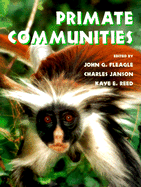Book contents
- Frontmatter
- Contents
- List of contributors
- Preface
- 1 African primate communities: Determinants of structure and threats to survival
- 2 Biomass and use of resources in south and south-east Asian primate communities
- 3 Species coexistence, distribution, and environmental determinants of neotropical primate richness: A community-level zoogeographic analysis
- 4 Primate communities: Madagascar
- 5 Primate diversity
- 6 Phylogenetic and temporal perspectives on primate ecology
- 7 Population density of primates in communities: Differences in community structure
- 8 Body mass, competition and the structure of primate communities
- 9 Convergence and divergence in primate social systems
- 10 Of mice and monkeys: Primates as predictors of mammal community richness
- 11 Comparing communities
- 12 Large-scale patterns of species richness and species range size in anthropoid primates
- 13 The recent evolutionary past of primate communities: Likely environmental impacts during the past three millennia
- 14 Resources and primate community structure
- 15 Effects of subsistence hunting and forest types on the structure of Amazonian primate communities
- 16 Spatial and temporal scales in primate community structure
- 17 Primate communities in Africa: The consequences of long-term evolution or the artifact of recent hunting?
- 18 The future of primate communities: A reflection of the present?
- 19 Concluding remarks
- Systematic index
- Subject index
7 - Population density of primates in communities: Differences in community structure
Published online by Cambridge University Press: 21 August 2009
- Frontmatter
- Contents
- List of contributors
- Preface
- 1 African primate communities: Determinants of structure and threats to survival
- 2 Biomass and use of resources in south and south-east Asian primate communities
- 3 Species coexistence, distribution, and environmental determinants of neotropical primate richness: A community-level zoogeographic analysis
- 4 Primate communities: Madagascar
- 5 Primate diversity
- 6 Phylogenetic and temporal perspectives on primate ecology
- 7 Population density of primates in communities: Differences in community structure
- 8 Body mass, competition and the structure of primate communities
- 9 Convergence and divergence in primate social systems
- 10 Of mice and monkeys: Primates as predictors of mammal community richness
- 11 Comparing communities
- 12 Large-scale patterns of species richness and species range size in anthropoid primates
- 13 The recent evolutionary past of primate communities: Likely environmental impacts during the past three millennia
- 14 Resources and primate community structure
- 15 Effects of subsistence hunting and forest types on the structure of Amazonian primate communities
- 16 Spatial and temporal scales in primate community structure
- 17 Primate communities in Africa: The consequences of long-term evolution or the artifact of recent hunting?
- 18 The future of primate communities: A reflection of the present?
- 19 Concluding remarks
- Systematic index
- Subject index
Summary
INTRODUCTION
The studies of primate communities that have compared primate species' ecological characteristics have found major differences among Africa, the Neotropics, Asia, and Madagascar (Raemaekers et al., 1980; Bourlière, 1985; Terborgh & van Schaik, 1987; Gautier-Hion, 1988; Ganzhorn, 1988, 1992; this volume; Terborgh, 1990; Fleagle & Reed, 1996; Kappeler & Heymann, 1996; McGraw, 1998). These studies have also shown ecological patterns within the same continental areas. However, most of these previous studies compare ecological differences among primate communities on different continents with attributes of individual species, i.e., contrasts in size, diet, and locomotor adaptations among individual species within communities. The unit of analysis is the species. Using these data, Fleagle & Reed (1996) showed that overall ecological space represented by ecological data occupied by primate species in communities were quite similar within continental areas, and were different between them. Thus, each primate species within each community held a particular position in ecological space (Hutchinson, 1978).
However, primates, for the most part, do not live individually. The density of primates, as well as diversity, presumably affects the size and shape of the ecological space that each community holds. For example, mammalian population density has been directly related to the size of an animal such that as animals get larger their population densities usually decrease (Fa & Purvis, 1997). It has been suggested that the scaling of this phenomenon is approximately the same for all mammalian herbivores (Damuth, 1981). Peters (1983) proposes that one of the most important reasons that population density falls with increasing body size is the constraint of food supply.
- Type
- Chapter
- Information
- Primate Communities , pp. 116 - 140Publisher: Cambridge University PressPrint publication year: 1999
- 18
- Cited by



